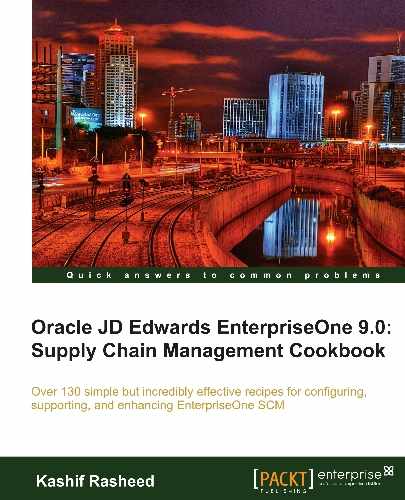This recipe demonstrates how to enter stock and non stock purchase orders, which includes the following:
- Entering order header information
- Entering order detail information
You should set up the processing options for Purchase Orders (P4310) in order to enter the purchase order.
- Select Procurement and Subcontract Management | Daily Processing | Stock Based Purchasing, and then click on Purchase Order Processing.
- On the Work With Order Headers form, click Add, and then enter the following information:

- Enter the Supplier information.
- Enter the Branch/Plant information.
- Enter the Order Date.
- Enter the Requested Date.
- Enter the Promise Delivery Date and then click OK.
- On the Order Detail form, click the Line Defaults tab and enter the G/L Date.
- Enter the Item Number on the detail line.
- Enter the Quantity Ordered.
- Enter the Transaction UOM.
- Enter the Unit Cost; the Extended Cost will be calculated automatically based on the Quantity Ordered.
- For Non Stock Item select Procurement and Subcontract Management | Daily Processing | Non Stock Purchasing, and then click on Purchase Order Processing.
- Enter the Account Number for Non Stock Item.
- Enter the Quantity Ordered.
- Enter the Unit Cost; the Extended Cost will be calculated automatically based on the Quantity Ordered.
When you enter the order header to generate an order, you must provide information about the supplier who is to fill the order, the branch/plant that is requesting the order, and the shipping address for the order. The header information that you enter determines how the system processes the order. For example, supplier information determines the address to which the order is sent, the payment terms for the order, and so forth. Origination information determines the business unit accountable for the order and the address to which the goods and services are to be delivered. Tax information determines how the system calculates taxes for the order. Header information also includes the date on which the order is placed, the date on which the order is due, and reference information such as the employee entering the order. Using the Processing Options for Order Entry, you can display a header form before the detail form. Depending on how you set the processing options, certain fields can display on the header form. If you bypass the header form, you must enter limited header information on the detail form. Based on the supplier and branch/plant that you enter, the system applies default values to the fields on the header form. After you enter an item number on a detail line, the system validates that the item exists in the Inventory Management system. The system retrieves information for the item from the Inventory Management system. The system provides default values for detail lines based on the header information on an order. The system retrieves information such as the cost, description, and unit of measure for the item, and enters it on the detail line. You can add and change the information for each detail line based on what is relevant to the purchasing process. For example, if you purchase items for inventory, you must specify the unit of measure for the item. You can also specify the location where the item is stored upon receipt, and the weight, volume, lot, and manufacturing information for the item. You can specify an asset identifier and landed cost rules. You also can attach notes, or narrative text, to each detail line.
If you purchase goods or services from international suppliers, you might need to enter order amounts in different currencies, such as Canadian dollars, Japanese yen, and the Euro. Before you can do this, you must specify on the header form if the supplier uses a foreign currency. The system completes the currency field on the Order Header form with the default currency, if any, that you establish for the supplier.
- Setting up purchase orders in Chapter 4,Understanding and Setting up Procurement
